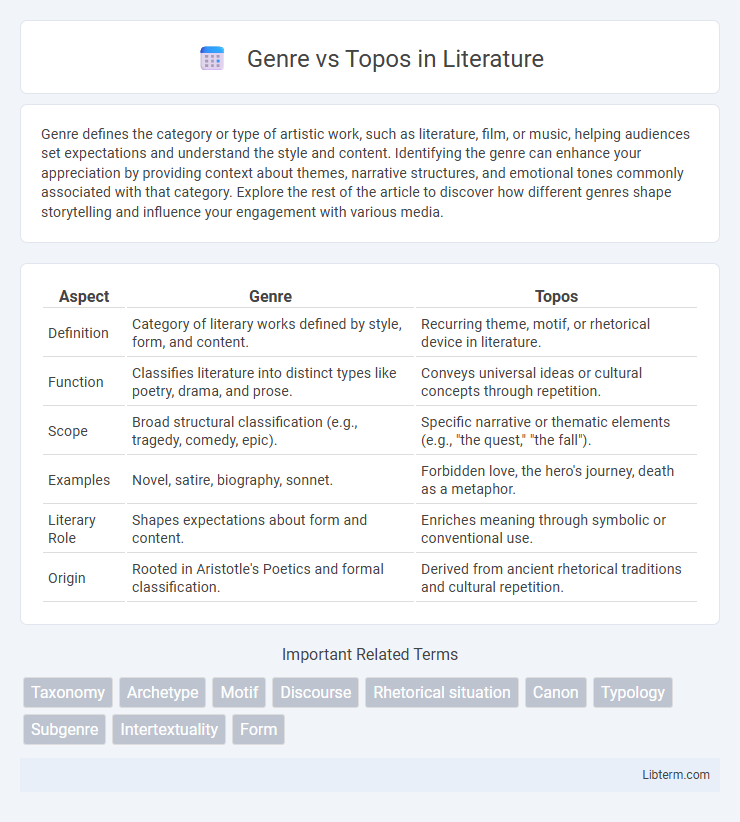Genre defines the category or type of artistic work, such as literature, film, or music, helping audiences set expectations and understand the style and content. Identifying the genre can enhance your appreciation by providing context about themes, narrative structures, and emotional tones commonly associated with that category. Explore the rest of the article to discover how different genres shape storytelling and influence your engagement with various media.
Table of Comparison
| Aspect | Genre | Topos |
|---|---|---|
| Definition | Category of literary works defined by style, form, and content. | Recurring theme, motif, or rhetorical device in literature. |
| Function | Classifies literature into distinct types like poetry, drama, and prose. | Conveys universal ideas or cultural concepts through repetition. |
| Scope | Broad structural classification (e.g., tragedy, comedy, epic). | Specific narrative or thematic elements (e.g., "the quest," "the fall"). |
| Examples | Novel, satire, biography, sonnet. | Forbidden love, the hero's journey, death as a metaphor. |
| Literary Role | Shapes expectations about form and content. | Enriches meaning through symbolic or conventional use. |
| Origin | Rooted in Aristotle's Poetics and formal classification. | Derived from ancient rhetorical traditions and cultural repetition. |
Understanding Genre: Definition and Scope
Genre refers to categories of artistic composition characterized by similarities in form, style, or subject matter, while topos denotes recurring themes or motifs across genres. Understanding genre involves recognizing structural conventions, narrative techniques, and audience expectations that define specific categories like tragedy, comedy, or science fiction. Its scope encompasses both literary and multimedia texts, influencing interpretation and classification in cultural and artistic contexts.
What is Topos? Exploring Its Roots
Topos, originating from the Greek word meaning "place," refers to a conventional theme or motif recurring across literature and rhetoric, serving as a common conceptual framework for argumentation or storytelling. Unlike genre, which classifies works by structure or style, topos functions as a building block of thematic content, often representing universal ideas or cultural archetypes found throughout various narratives. Its roots in classical rhetoric highlight its role in shaping persuasive discourse and organizing knowledge by identifying familiar patterns that resonate across different contexts.
Historical Development of Genre and Topos
The historical development of genre traces its roots to ancient rhetorical traditions where texts were classified based on form and function, evolving through classical antiquity to modern literary theory with distinct categories such as tragedy, comedy, and epic. Topos, originating from Aristotle's concept of "topoi" or commonplaces, developed as recurring themes or motifs used in argumentation and storytelling, serving as a foundational tool for rhetorical invention and literary analysis. Over time, both genre and topos have intersected, with genres adopting common topos structures to establish thematic conventions and shape narrative expectations.
Key Differences Between Genre and Topos
Genre categorizes works based on shared narrative structures, themes, and stylistic elements, such as drama, comedy, or horror. Topos refers to recurring literary motifs or traditional themes, like the "hero's journey" or "forbidden love," found across multiple genres. The key difference lies in genre defining the overall type of a work, while topos highlights specific, repeated thematic ideas within or across genres.
Functions of Genre in Literature and Media
Genres function as organizational frameworks that guide audience expectations and shape narrative structures in literature and media. They facilitate communication by providing recognizable conventions and patterns, enabling creators to effectively convey themes and emotions. Genres also serve as cultural tools that reflect societal norms and values, while allowing for innovation through the blending or subversion of established tropes.
The Role of Topos in Rhetoric and Storytelling
Topos functions as a foundational rhetorical device by providing commonplaces or thematic templates that guide argument construction and narrative development. Unlike genre, which categorizes works based on shared structural and stylistic features, topos offers a repertoire of familiar motifs and strategies that speakers and writers invoke to persuade and engage audiences effectively. The strategic use of topos enhances storytelling by tapping into culturally recognizable patterns, enriching the narrative's persuasive power and emotional resonance.
How Genres Shape Audience Expectations
Genres establish specific conventions and stylistic elements that guide audience expectations by signaling familiar themes, narrative structures, and character archetypes. Topoi, or common thematic motifs, reinforce these expectations by providing recognizable patterns that audiences anticipate within a genre context. This framework enhances engagement by allowing viewers to predict story developments and emotional responses based on genre cues.
Topos as a Tool for Persuasion and Argument
Topos, derived from classical rhetoric, functions as a strategic tool in persuasion by providing commonplaces or lines of argument that speakers and writers use to develop effective appeals. Unlike genre, which categorizes texts based on form and content, topos offers a flexible framework for identifying recognizable themes and reasoning patterns that resonate with audiences and enhance argumentative impact. Mastery of topos empowers communicators to construct compelling, contextually relevant arguments that strengthen persuasion and influence.
Intersections: When Genre Meets Topos
Genre and topos intersect by shaping narrative expectations and thematic frameworks within literature and media. While genre categorizes works based on formal conventions like plot structure and style, topos refers to recurring themes or motifs derived from cultural and rhetorical traditions. This intersection allows creators to blend familiar thematic elements with genre-specific storytelling techniques, enhancing both audience recognition and interpretive depth.
The Relevance of Genre and Topos in Modern Discourse
Genre shapes the framework and expectations within communication, guiding the structure and style of discourse, while topos provides recurring themes or arguments that enrich content relevance and persuasiveness. In modern discourse, understanding the interplay between genre and topos enhances clarity, engagement, and the effectiveness of message delivery across diverse platforms. This semantic synergy is crucial for tailoring communication strategies in digital media, marketing, and academic contexts.
Genre Infographic

 libterm.com
libterm.com